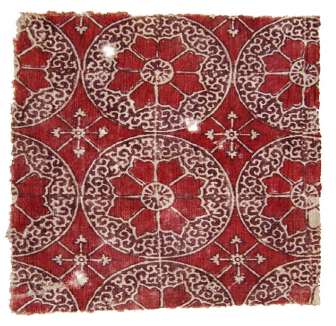English: Indian textile fragment found in Fustat, Egypt, circa 1545 - 1645
This small fragment, found in the ancient town of Fustat, was preserved in the dry climate of Egypt. The town was deserted after the Egyptian capital moved to Cairo, slightly to the north. Fustat was located on a canal connected to the Nile, which helped to stimulate trade with other regions. The printing techniques used to create the different designs on this textile indicate an Indian origin. Cotton printed textiles were produced in India for export to the Islamic lands. These textiles were especially popular in Egypt.
The cotton ground of this fragment was dyed using one technique but two different types of application. The brown colored pattern is formed by the use of a mordant applied to the ground cloth with a single stamp. The stamp is coated with the mordant (a metallic salt) and then pressed onto the cloth. The cloth is then immersed in a dye bath. The mordant helps bind the dyes, creating a pattern. The mordant for the red dye was applied in a different way: iInstead of using a block to apply the mordant, it was painted on, possibly with a brush.
The Fustat fragments tend to be in either blue or red dyes. The patterns on these printed textiles vary from intricate designs to more open patterns such as seen in this piece. If you look carefully at this example, you can see the lines of the square block forming the quarter circles with the star shape in the middle.
- Cotton, plain weave, dyed, stamped, painted,
- 24 cm x 21 cm
- The Textile Museum 73.408 --
- Acquired by George Hewitt Myers in 1933

